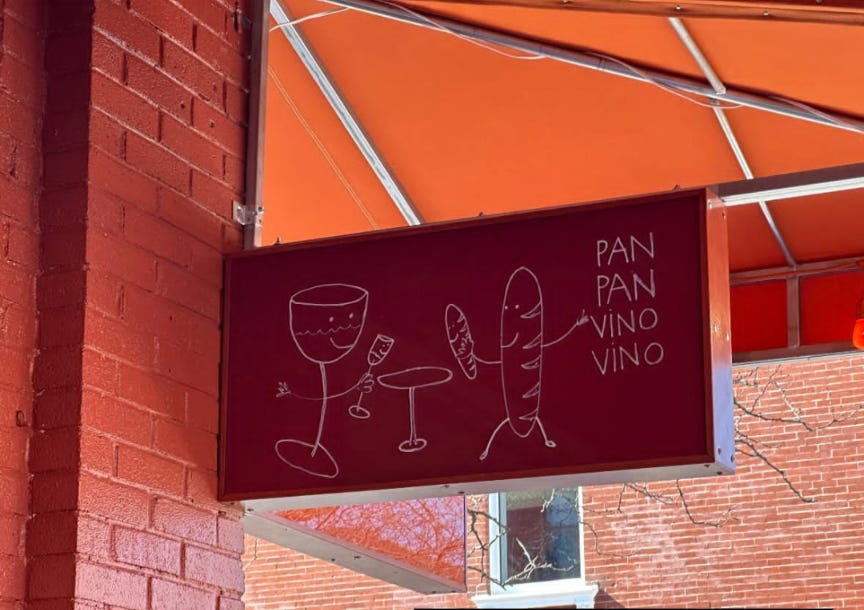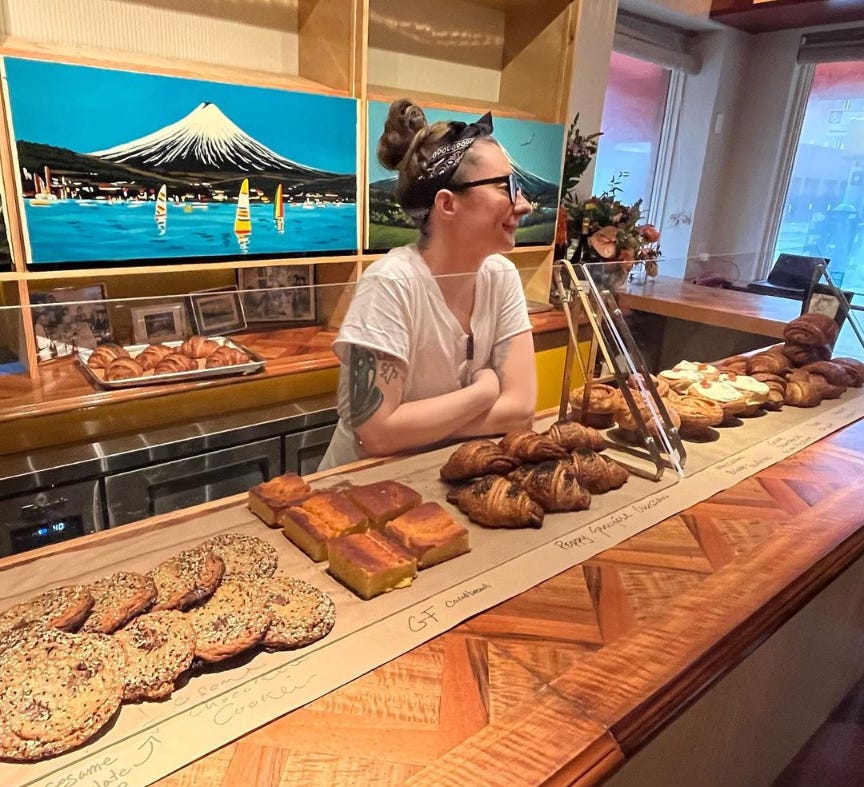Sweet; like Portuguese Rolls Dipped in Hot Chocolate with Pastry Chef Sam Short - No. 27
And a big cheers to her new bakery, Pan Pan Vino Vino.
Welcome to Just Peachy! If you haven’t already, please subscribe to receive a monthly grin—in the form of my newsletter hitting your inbox. Go ahead, I’ll wait.
What can you expect in each newsletter? Sweet stories from women and non-binary people in food. These are chefs, restauranteurs, farmers, and creatives—all with unique, nerdy-passionate opinions to share.
It’s official! Greenpoint has become one of my favorite food neighborhoods. And I swear, it’s not just because I work there. It’s truly home to so many goodies! From Polish dumplings and doughnuts, to amazing ramen or Korean fried chicken. El Penguino for wine and oysters. Spots like Achille’s Heel, Wenwen, or Taqueria Ramirez—all within a few block’s radius. Plus, has anyone noticed the density of specialty markets? Each seemingly more perfect than the next. I could go on. I can only think of one thing to make it better—and that’s Sam’s pastries.
Today, I have the honor of sharing my interview with Executive Pastry Chef Sam Short. Formerly of Roberta’s Pizza and Blanca, Sam is the pastry mastermind behind Nura — where her raved-about bread baskets and desserts are not to be missed. As luck would have it, she just opened her first concept in Greenpoint last weekend called Pan Pan Vino Vino: a bakery by day and wine bar by night. Her new spot features Eastern-European treats inspired by her Polish heritage, like rye caraway bread, sesame chocolate chip cookies, and laminated pastries galore—including a gruyere poppyseed croissant and guava cream cheese bun. In the evening, wine is flowing along with small plates curated by Chef Jackie Carnesi, the opening chef at Nura. I was so excited to pick Sam’s library of a brain a bit, as it’s curated of some of my favorite topics like sweets, nostalgia, infusions, fermentation, and all things science + baking. Whether you’re a fan of baking and history, or maybe you were raised Catholic in NJ and like Bob’s Burgers—not sure that these are associated, they’re just facts about Sam—this piece has something for you.
Who is Sam Short
Sam grew up in a small town near Edison, NJ called Fords. Her mother’s side is Polish, and her father’s Irish Catholic (his is a real small family, you know, just 11 brothers and sisters). It’s also important to add that growing up in New Jersey, Sam says she’s a little Italian by osmosis. With all of this in mind, big meals were at the center of family gatherings. Easter and Christmas were especially packed with tradition—eating all blessed foods*, wafers representing the eucharist, and washing down said salty crackers with blackberry brandy.
*for those unfamiliar with Catholic practices, “blessed food” is food blessed by your Priest. He comes by to bless everything for Easter; butter, horseradish condiment, hard-boiled eggs, all of it.
When did you first discover your love of baking?
Sam remembers bread fondly. Mostly in part to her Polish grandmother, who’d ask every morning if she’d like crepes or anything she was whipping up with a side of caraway rye. Her late-night snacks, Portuguese rolls with butter dipped in hot chocolate, in the afternoon maybe perogies, Polish doughnuts, or enriched breads like babka. Her grandmother was the type to cook and feed everyone, never sitting down to feed herself—sound like anyone we know? Much to her surprise, she learned later on that her grandmother didn’t like cooking at all. “It was sometime while I was in culinary school. We were cooking together, and she leaned in and told me ‘You know, I don’t really like cooking.’ I was blown away. To me, it was her whole identity.”
She explained walking into her grandmother’s home—barely able to open her eyes whenever she made her preserved horseradish and beet condiments. Visiting Polish delis, or grocery stores with her, and discover cute cultural similarities between Polish and Puerto Rican grandmas—all shopping in babushkas with their grandchildren for pigs or chicken’s feet. How all of those experiences, while growing up in a densely diverse area like Fords, NJ, truly connected her to the vastness of food.
“Bread is special. Every culture has a different way but it’s the same ingredients, the same connotation of breaking bread, and it’s the basis of every meal.”
Sam continued to recall stories of her grandmother and the more she did, the more I saw how connected baking makes her feel to her, even now. If you’d like a taste—try the pineapple preserve Sam uses at Nura during brunch, alongside cornbread, toast, and spiced butter. It’s the same one her grandmother used for her cookies.
What do you do outside of cooking that inspires you?
There was a pause and a funny face with this question—the kind that tells you food really is at the center of her focus. And while her obsession with baking is central to her other hobbies, her answer is reading about history and science. Growing up, she’d always have her nose in a book—a cereal bowl strategically placed to keep the page open. Now, Sam reads to learn the cultural significance of foods; the history behind a dish, a traditional practice, or why each came to be. She insists that knowledge of such is the best way to respect those who created it in the first place.
“I’ll get lost in deep dives on things like, how did we make cheese? And learn people carried dairy in bladders, essentially, and then acidity separated the curds and whey…cool! The more I learn, the more I’m inspired to say—now, how can we try it too?”
Learning about cheese led the team to make their own paneer and eventually to culture their butter and make their own yogurt—you can really taste the difference, by the way! Her approach to food science is similar to her approach to history in that, initially, it was her surroundings that inspired. In this case, I’m speaking about her externship at WD50, chef Wylie Dufresne’s famed New American, molecular gastronomy restaurant. It listed among the S. Pellegrino World's 50 Best Restaurants in 2010. At WD50 Sam learned to gel, infuse, and dehydrate to enhance flavor. Later on, she worked at a spot in Nashville that did a lot of their own fermentation—for those of you interested in trying fermentation at home, Sam suggests referencing the Noma fermentation guide. But I learned from our conversation that a safe fermentation brine consists of 2% salt. A fun fact that brings us to another book Sam loves, called Salt on the history of salt. Or by the same author, check out Cod, on the history and exploration of salt and cod. How fishermen preserved their Cod while out on long voyages, and how those long voyages led to the darker side of early world trading and the Dutch East India Company. Talk about connecting knowledge to your food!
What are you making at home?
Known for not stopping enough to eat, cooking at home for Sam is all about convenience. She makes a lot of ramen*, soup, smoothies, roast chicken and vegetables, or her favorite, a big batch of chicken salad that she eats, often with an entire sleeve of Ritz crackers. Plus, don’t get her started on kimchi and sauerkraut! She loves the stuff and swears to put it on 90% of the things she eats at home.
*Sam’s Ramen Tips: If you want a fresh noodle, you can’t go wrong with Sun Noodle brand. As far as flavor profile, she loves Korean ramen of all sorts but most often goes for a black bean ramen called chapaguri, or a spicy seafood ramen called neoguri—traditionally these two types are mixed to create a spicy and creamy ramen.
What should we order at Pan Pan Vino Vino?
Sam is excited about several items—their caraway rye, sesame semolina bread, and their gluten-free corn bread. Along with these, she is interested in exploring unique savory and sweet/savory combinations in their Vienoisserie. Among the current combinations are sunchokes, chocolate, and caramel, as well as a cheese and charred pepper croissant. YUM! I can’t wait to see what else you come up with.
Thank you again, Sam, for sharing your story and for sharing your knowledge with the world. I am endlessly inspired by you!






